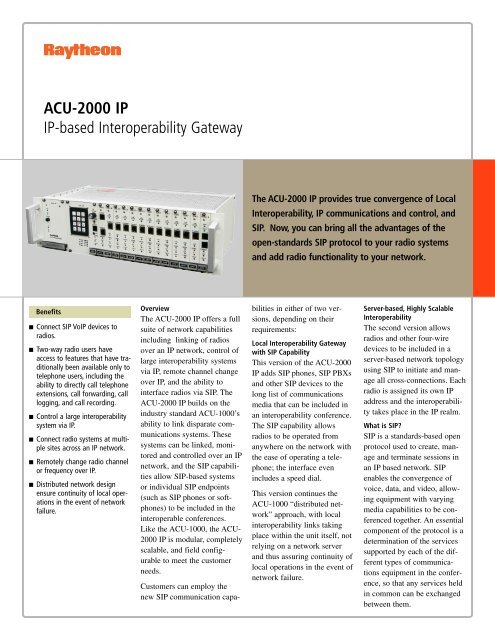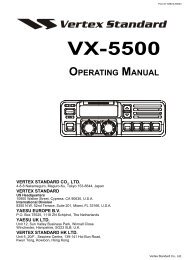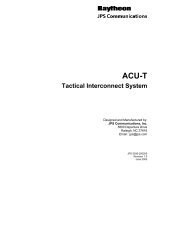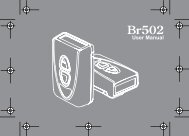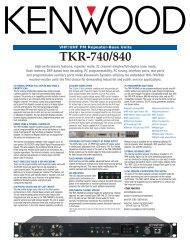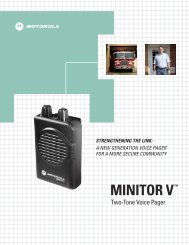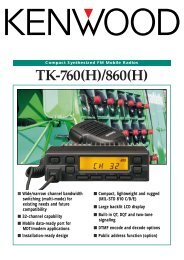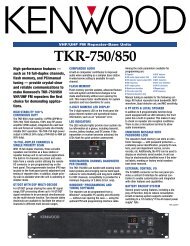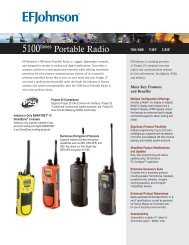ACU-2000 IP - Lauttamus Communications
ACU-2000 IP - Lauttamus Communications
ACU-2000 IP - Lauttamus Communications
Create successful ePaper yourself
Turn your PDF publications into a flip-book with our unique Google optimized e-Paper software.
<strong>ACU</strong>-<strong>2000</strong> <strong>IP</strong><br />
<strong>IP</strong>-based Interoperability Gateway<br />
The <strong>ACU</strong>-<strong>2000</strong> <strong>IP</strong> provides true convergence of Local<br />
Interoperability, <strong>IP</strong> communications and control, and<br />
S<strong>IP</strong>. Now, you can bring all the advantages of the<br />
open-standards S<strong>IP</strong> protocol to your radio systems<br />
and add radio functionality to your network.<br />
<br />
<br />
<br />
<br />
<br />
<br />
Benefits<br />
Connect S<strong>IP</strong> Vo<strong>IP</strong> devices to<br />
radios.<br />
Two-way radio users have<br />
access to features that have traditionally<br />
been available only to<br />
telephone users, including the<br />
ability to directly call telephone<br />
extensions, call forwarding, call<br />
logging, and call recording.<br />
Control a large interoperability<br />
system via <strong>IP</strong>.<br />
Connect radio systems at multiple<br />
sites across an <strong>IP</strong> network.<br />
Remotely change radio channel<br />
or frequency over <strong>IP</strong>.<br />
Distributed network design<br />
ensure continuity of local operations<br />
in the event of network<br />
failure.<br />
Overview<br />
The <strong>ACU</strong>-<strong>2000</strong> <strong>IP</strong> offers a full<br />
suite of network capabilities<br />
including linking of radios<br />
over an <strong>IP</strong> network, control of<br />
large interoperability systems<br />
via <strong>IP</strong>, remote channel change<br />
over <strong>IP</strong>, and the ability to<br />
interface radios via S<strong>IP</strong>. The<br />
<strong>ACU</strong>-<strong>2000</strong> <strong>IP</strong> builds on the<br />
industry standard <strong>ACU</strong>-1000’s<br />
ability to link disparate communications<br />
systems. These<br />
systems can be linked, monitored<br />
and controlled over an <strong>IP</strong><br />
network, and the S<strong>IP</strong> capabilities<br />
allow S<strong>IP</strong>-based systems<br />
or individual S<strong>IP</strong> endpoints<br />
(such as S<strong>IP</strong> phones or softphones)<br />
to be included in the<br />
interoperable conferences.<br />
Like the <strong>ACU</strong>-1000, the <strong>ACU</strong>-<br />
<strong>2000</strong> <strong>IP</strong> is modular, completely<br />
scalable, and field configurable<br />
to meet the customer<br />
needs.<br />
Customers can employ the<br />
new S<strong>IP</strong> communication capabilities<br />
in either of two versions,<br />
depending on their<br />
requirements:<br />
Local Interoperability Gateway<br />
with S<strong>IP</strong> Capability<br />
This version of the <strong>ACU</strong>-<strong>2000</strong><br />
<strong>IP</strong> adds S<strong>IP</strong> phones, S<strong>IP</strong> PBXs<br />
and other S<strong>IP</strong> devices to the<br />
long list of communications<br />
media that can be included in<br />
an interoperability conference.<br />
The S<strong>IP</strong> capability allows<br />
radios to be operated from<br />
anywhere on the network with<br />
the ease of operating a telephone;<br />
the interface even<br />
includes a speed dial.<br />
This version continues the<br />
<strong>ACU</strong>-1000 “distributed network”<br />
approach, with local<br />
interoperability links taking<br />
place within the unit itself, not<br />
relying on a network server<br />
and thus assuring continuity of<br />
local operations in the event of<br />
network failure.<br />
Server-based, Highly Scalable<br />
Interoperability<br />
The second version allows<br />
radios and other four-wire<br />
devices to be included in a<br />
server-based network topology<br />
using S<strong>IP</strong> to initiate and manage<br />
all cross-connections. Each<br />
radio is assigned its own <strong>IP</strong><br />
address and the interoperability<br />
takes place in the <strong>IP</strong> realm.<br />
What is S<strong>IP</strong>?<br />
S<strong>IP</strong> is a standards-based open<br />
protocol used to create, manage<br />
and terminate sessions in<br />
an <strong>IP</strong> based network. S<strong>IP</strong><br />
enables the convergence of<br />
voice, data, and video, allowing<br />
equipment with varying<br />
media capabilities to be conferenced<br />
together. An essential<br />
component of the protocol is a<br />
determination of the services<br />
supported by each of the different<br />
types of communications<br />
equipment in the conference,<br />
so that any services held<br />
in common can be exchanged<br />
between them.
<strong>ACU</strong>-<strong>2000</strong> <strong>IP</strong><br />
When the situation is critical, your team needs integrated voice, data, and multimedia<br />
communications in conjunction with seamless interoperability. Only the<br />
new <strong>ACU</strong>-<strong>2000</strong><strong>IP</strong> from JPS provides a true S<strong>IP</strong>-based gateway to digitally converge<br />
existing radio systems with S<strong>IP</strong> telephones, networks, and devices. Now<br />
you can bring all of the advantages of the open-standards S<strong>IP</strong> protocol to your<br />
radio systems and add radio functionality to your network.<br />
Radio/4W Interface Specifications<br />
Audio Input: Balanced or Unbal 600 ohms or Hi-Z; -26dBm to +12dBm levels; 100Hz to 3200 Hz.<br />
Audio Output: Balanced or Unbal 600 ohms; -26dBm to +12dBm levels; 100Hz to 3200 Hz.<br />
Digital I/O: COR/Squelch and AUX inputs, PTT, and AUX outputs; E&M input/output.<br />
DSP Algorithms: VOX or VMR Voice Detection; TD-Mode Noise Reduction; DTMF; Audio Equalizer; TX and/or RX Audio<br />
delay; Peak Limiter; COR Sampling; TX Keying tones.<br />
S<strong>IP</strong> Network Interface<br />
RFC Supported: 3261, 2976, 3515, 2327, 3264, 1889<br />
S<strong>IP</strong> Support Vocoders: GSM and G711u<br />
Telephone Line Interface<br />
Phone Line: RJ-11 Connectors (2); -24 dBm to 0 dBm levels.<br />
DSP Algorithms: DTMF Detection and Generation; DSP Adaptive Hybrid, DSP VOX<br />
Ro<strong>IP</strong> Interface (Radio over <strong>IP</strong>)<br />
Network Interface: RJ-45 Connector; 10/100Base-T Ethernet<br />
Radio-Centric Features: Audio delay and jitter buffers to handle network latency; embedded COR, PTT, and RS-232<br />
serial control; three audio vocoder types.<br />
Programming/Configuration: HTTP (Password Protected Web)<br />
Network Interface Type: 10/100BASE-T Ethernet, 100Mbps; RJ-45 Connector<br />
General/Environmental<br />
AC Input Power : 115 to 230 VAC + 15% 47-63Hz, 80VA Typical, 100 VA Maximum<br />
DC Input Power : +11 to +15 VDC @4A Nominal<br />
Battery Charger : 1A Output Maximum; Tapered charge circuitry for a lead-acid battery<br />
Size and Weight : 5.25”H x 19”W x 11”D (13.3 x 48.3 x 28cm)<br />
Temperature : Operating: -20 to +60 degrees C. Storage: -40 to +85 degrees C<br />
Raytheon Company<br />
JPS <strong>Communications</strong><br />
5800 Departure Drive<br />
Raleigh, NC 27616<br />
sales@jps.com<br />
www.raytheon.com/JPS<br />
Cleared for public release. Copyright © 2007 Raytheon Company. All rights reserved.<br />
Printed in the USA. RSAS MS 2/07 DS-<strong>ACU</strong><strong>2000</strong><strong>IP</strong>-01


